Abstract
Background
This article presents an acoustically enhanced microfluidic mixer to generate highly uniform and ultra-fine nanoparticles, offering significant advantages over conventional liquid antisolvent techniques.
Methods
The method employed a 3D microfluidic geometry whereby two different phases – solvent and antisolvent – were introduced at either side of a 1 μm thick resonating membrane, which contained a through-hole. The vibration of the membrane rapidly and efficiently mixed the two phases, at the location of the hole, leading to the formation of nanoparticles.
Results
The versatility of the device was demonstrated by synthesizing budesonide (a common asthma drug) with a mean diameter of 135.7 nm and a polydispersity index of 0.044.
Conclusion
The method offers a 40-fold reduction in the size of synthesized particles combined with a substantial improvement in uniformity, achieved without the need of stabilizers.
Introduction
Approximately 40% of drugs used in the pharmaceutical industry are poorly soluble, which results in poor bioavailability and uncontrollable precipitation after dosing and requires employment of extreme basic/acidic conditions to enhance solubility.Citation1 The drug’s dissolution rate can be increased proportionally by reducing its size to nanometer scales, hence increasing its surface area-to-volume ratio.Citation2–Citation4 Using nanoscale drugs also provides a wide range of therapeutic advantages,Citation5–Citation11 enhances targeted delivery to specific tissues, and improves the effectiveness of the drug by lowering its resistance and dose requirement.Citation12,Citation13 In aerosol drug delivery, particle size plays a critical role in determining how deep the drugs will be deposited,Citation14,Citation15 hence providing a crucial advantage to treat lung diseases.Citation16–Citation21
There are two common approaches to synthesize nanodrugs. The first of these, the attrition method, is a “top-down” approach, which relies on breaking down the bulk structure of the drug into finer sizes.Citation22 The method is capable of generating nanodrugs without employing harsh solvents;Citation23 however, it requires a significant amount of energy to reduce the sizes to submicron levels and hence generates a high level of heating during operation, which may alter the physical state of drugs and surfactants.Citation24 The alternative “bottom-up” techniques aim to synthesize the drugs from smaller elements.Citation25–Citation27 The widely used liquid antisolvent (LAS) method offers relative simplicity by combining room temperature operation with low pressure requirements (in contrast to other methods such as supercritical antisolvent method,Citation28 where high pressures are required).Citation23 The LAS procedure is solely based on the nucleation of the drug when two different liquid phases are mixed. One phase is the solvent phase, where the drug of interest is dissolved. The addition of antisolvent phase into the solvent creates a supersaturated concentration environment, which affects the nucleation rate of the particles.
Typically, higher nucleation rates result in a larger proportion of submicrometer sized particles. However, during the mixing, the nucleation rate competes with the condensation and coagulation of the particles, which in turn work to reduce the supersaturation condition, hence increasing the particle size. Damkoehler number, Da = tmix/tprecipitation (where tmix is the mixing time and tprecipitation is the precipitation time), affects the nucleation rate, and the larger Da values result in larger particle sizes.Citation29 Particle size can be reduced by increasing tprecipitation often by means of additives and stabilizers,Citation30 which coat the nanoparticle surface to prevent unwanted growth of the drug in suspension.Citation31 Size reduction can also be achieved by reducing the mixing time tmix and delaying precipitation through mechanical means. Here, we demonstrate an acoustically enhanced microfluidic method to significantly reduce the mixing time (down to 3 ms), and synthesize highly uniform, ultrafine particles without the use of stabilizers. Avoiding stabilizers is particularly desirable as their addition during production can cause toxicity issues and undermine the therapeutic efficiency of the drug.Citation24 Moreover, selecting the optimal surfactants is often burdensome, as the interaction between drugs and added emulsions is poorly understood at nanoscales.
Central to the approach is a vibrating membrane, which is embedded in a microfluidic channel. Under acoustic excitation, the interaction of the resonating membrane with the surrounding fluid media generates an acoustic streaming field and corresponding very strong vortices.Citation32 As a result, the antisolvent and solvent phases are rapidly and efficiently mixed creating the necessary supersaturation condition for the drugs with ultrafine particle sizes to nucleate while preventing accumulation of the formed particles. The commonly used asthma medication budesonide was chosen as a suitably well-characterized test case for the experiments aimed at demonstrating performance of the method.Citation33–Citation36 Budesonide is one of the most valuable therapeutic agents to treat pulmonary diseases yet its low aqueous solubility limits its absorption after oral delivery and poses a challenge for its efficacy. Generating a monodisperse suspension of submicrometer-diameter budesonide particles can address this issue.Citation37,Citation38 Numerous other methods were previously employed to synthesize budesonide nanodrugs. For instance, oil-in-water (O/W) emulsion evaporation techniques resulted in 200 nm diameter particles in the presence of surfactants.Citation39 640 nm diameter particles were possible without surfactants by using a high-pressure homogenizing method, at 60 cycles and <1,000 bars of pressure.Citation40 The technique presented here combines operational simplicity with small diameter nanoparticles while avoiding the use of stabilizers, hence it offers a significant advantage over the earlier approaches.
Methods
Microfluidic device preparation
The device consists of a 500 μm wide, 50 μm deep polydimethylsiloxane (PDMS) microfluidic channel assembled with a free standing, 1,000 nm thick silicon nitride membrane (), through which a hole is etched. For the membranes, the front-side geometric features and back-side openings are patterned on 1 μm thick silicon nitride (SiN)-coated (100)-oriented Si wafers (4D LABS, Burnaby, BC, Canada) using a combination of photolithography and reactive ion etching (RIE). The wafers are then immersed in a 5 M potassium hydroxide (KOH) solution at 65°C for ~15 hours to selectively etch the Si and release the free-standing SiN membranes.
Figure 1 Device schematic and operation.
Notes: (A) Schematic representation of the micromixer device; the solvent is fed from the bottom side of the silicon nitride while antisolvent phase is introduced in the top layer. (B) A simplified summary of the fabrication steps, showing how the channel and the membranes are fabricated with RIE, KOH etching, and DRIE. (C) A Solidworks 3D model, showing how the piezoelectric disk is assembled into the device, and (D) experimental snapshots demonstrating the mixing of two liquids before and after acoustic actuations (fluorescent dye was used to enhance visualization).
Abbreviations: DRIE, deep reactive ion etching; KOH, potassium hydroxide; RIE, reactive ion etching; PDMS, polydimethylsiloxane.
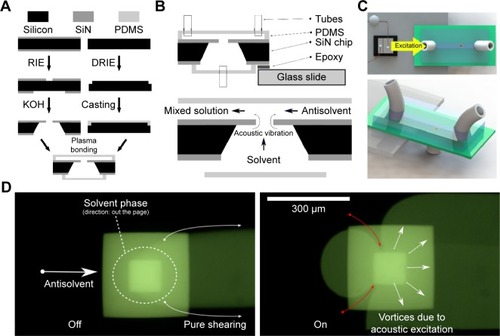
The PDMS channels are fabricated using standard procedures. After a mold of the channel geometry is etched by deep RIE (DRIE) into a Si wafer, its surface is rendered hydrophobic by a layer of Teflon coating. A PDMS solution mixed with curing agent, SYLGARD® 184 (Dow Corning, MI, USA) at ratio 10:1 (w/w), is cast on the mold. The mixture is left in a vacuum pump for 2 hours and then on a hot plate at 65°C for complete curing.
To assemble the devices, the PDMS channels are cut and bonded onto the chips containing individual membranes. The entire chip is then adhered onto a glass microscope slide, as shown in . A tube connector attached to the underside of the membrane () allows a solution of diluted drugs to access the microfluidic channel.
The operation of the micromixer is vastly different when the piezoelectric transducer (PZT) is turned on and off, as shown in . In the absence of acoustic excitation, the fluids are separated within the channel with a clearly defined boundary. Once the device is activated, this boundary is replaced with the mixed solution, which covers the width of the channel; the device generates vortices around the membrane to rapidly mix the solution.
Materials
Budesonide was supplied by Yicheng Chemical Corporation (Jiangsu, China). Ethanol (99.7%, v/v; Merck Millipore, Billerica, MA, USA) was employed as the principal solvent for the poorly dissolved drug. Purified water (Milli-Q®; Millipore Merck, Darmstadt, Germany) was used as the antisolvent for the system. Throughout the experiments, the ratio between solvent and antisolvent was kept constant at 1:4.
Experimental procedures – particle preparation and characterization
During the experiments, the membrane was excited at its resonant frequency (ranging from 100 to 300 kHz depending on the geometries used) by a PZT glued onto the glass slide. The PZT was driven by a signal generator (Stanford Research Systems DS345) and an amplifier (AG 1006; T&C Power Conversion, Inc., Rochester, NY, USA) at 200 peak-to-peak voltage (Vpp). The membrane’s resonant frequency is found experimentally by frequency sweeping.
After synthesis, the size and distribution of particles were characterized through a dynamic light scattering (DLS) system (Zetasizer Nano ZS; Malvern Instruments, Malvern, UK), which surveys particles in suspension. The system analyzed the velocity distribution of particles moving by Brownian motion, providing a distribution of particle sizes (with a minimum of 10 measurements for each distribution). Typically, a solution of 400 μL was examined in a narrowed cuvette. DLS results provide a Z-average diameter (which corresponds to the mean diameter of the particles in the nanosuspension) and a polydispersity index (PDI), a dimensionless measure of the spread within the distribution. PDI values that are close to 0 indicate monodisperse particle sizes, whereas values approaching 1 indicate a wide spread in the particle size distribution. Typically, a PDI value of <0.05 is considered to be highly monodisperse,Citation41 while PDI values ranging from 0.2 to 0.5 are considered to represent a relatively narrow particle size distribution.Citation3,Citation42
As a final characterization step, scanning electron microscopy (SEM) was performed to determine the size and shape of the produced nanoparticles. Prior to SEM, the solution was positioned on a glass slide and liquid was allowed to evaporate at room temperature. This slide was then sputter-coated with gold for 90 seconds with a current of 25 mA. The samples were then imaged with an FEI Nova NanoSEM 430 Instrument.
During the experiments, we investigated two different configurations. First (mode 1, ), solvent and antisolvent were fed from the top surface of the membrane; mixing took place at the through-hole where acoustic excitation generated a strong vortex. For mode 2 operation (), the solution was introduced on the top channel and the antisolvent was added from the underside, via the through-hole in the membrane. In mode 2, the antisolvent was pumped from the underside in mode 2a; in contrast, the solvent was introduced from the bottom in mode 2b. As shown in , mode 2b results in the smallest mean particle diameter and the most uniform distribution of nanoparticles, hence this mode of operation was employed throughout the experiments.
Figure 2 Comparison between different operational modes of the micromixer.
Notes: (A) Simplified schematic diagrams, and (B) DLS results, demonstrating the particle size and distribution for different modes, considering 10 measurements on 400 μL samples. The mean particle diameters and standard deviations are 99±80, 136±61, and 120±44 nm for modes 1, 2a, and 2b, respectively.
Abbreviation: DLS, dynamic light scattering.
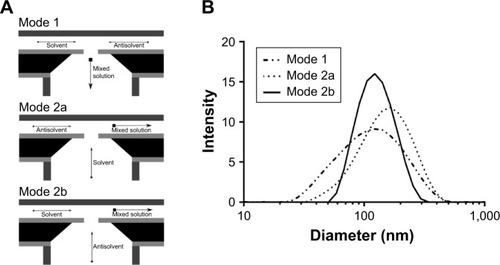
Results
The comparison of the particle size distribution with and without acoustic excitation of the membrane is presented in , in which the flow rate was fixed at 8 μL/minute, the drug concentration was 0.2 mg/mL, and the membrane was actuated at a frequency of 177.6 kHz. As expected, the particle size distribution in both cases follows a log-normal distribution.Citation43,Citation44 Without any actuation, the passive 3D T-junction proposed in this study is capable of reducing the mean size of the particles to 210.3±154.8 nm (based on 10 repeat measurements). This is already a 20-fold reduction in size in comparison to other microfluidic techniques employing passive T-junction mixers, for which the average particle size was 5.85 μm in the absence of stabilizing chemicals.Citation45
Figure 3 The effect of actuation on the particle diameter of budesonide – activation at 177.6 kHz with the flow rate of 8 μL/minute with a concentration of 0.2 mg/mL (results are based on 10 measurements).
Note: Inset: scanning electron micrograph of the particles (scale bar: 500 nm).
Abbreviation: PEG, polyethylene glycol.
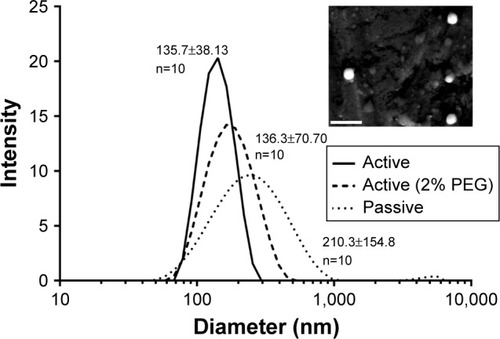
After the acoustic feature of the mixer was activated, the average particle diameter was further reduced to 135.7 nm. Moreover, the uniformity improved dramatically, the PDI changed from 0.238 down to 0.044, and the standard deviation in particle diameter was reduced from 154.8 to 38.13 nm. Interestingly, when 2 wt% polyethylene glycol (PEG), a commonly used stabilizer, was added into the system, the standard deviation increased twofold, the PDI value increased to 0.3 from 0.044, and the mean particle size was practically unchanged. This is clearly shown in DLS particle size distribution (). As suggested in earlier work, applying ultrasound in multiphase systems can be used to stabilize and reduce the size of emulsions.Citation46 In order to confirm the repeatability and uniformity of the results, the synthesis experiments were repeated 14 different times under identical conditions. For each experiment, mean diameters were calculated after 10 repeat measurements. The estimated mean diameter is 136.4 nm with a standard deviation of 1.06 nm for mean values, hence indicating that the results are highly repeatable.
Introduction of the active mixing during the LAS process enhanced the induction period, nucleation rate, and metastable zone width. As the antisolvent was rapidly mixed with the organic solvent for the solution to reach supercritical concentration, the insoluble drugs emerged from the solvent solution.
Many studies have shown the advantages of ultrasound in crystallization. For instance, ultrasound probe was used in a T-junction channel to enhance the uniformity of particles.Citation46–Citation48 The effect of ultrasound in the crystallization process was investigated in a milli-fluidic device which employed a PZT plate vibrating beneath the mixing channel.Citation49 Similarly, numerous studies of antisolvent crystallization were considered,Citation50,Citation51 where ultrasound was introduced from the bottom of the beakers while mixing was enhanced via diffusion or mechanical rotation of a stirrer. All of these have shown varying levels of improvement in the uniformity and size of particles across different studies.
A more recent study in 2016Citation52 used ultrasound to reduce the diameter of budesonide-loaded solid lipid to 170–200 nm. However, it should be noted that this process requires an extremely long homogenization time and involves the use of complex solutions of Lipoid S100, S154, and budesonide. In contrast, our device homogenizes a continuous solution without emulsifiers at significantly shorter times. The mixing occurs almost instantaneously. The difference can be accounted for by the fact that ultrasound is integrated fully as a driving mechanism of mixing, rather than simply aiding the process; this enables a fast mixing time and a total elimination of surfactants from the process.
The device performance was investigated at concentrations ranging from 0.2 to 1 mg/mL under a fixed flow rate of 20 μL/minute with a square-shaped membrane actuated at 156.7 kHz. As the concentration of the drugs increased by fivefold, the mean particle diameter was observed to change to 212.7 nm, still offering a considerable improvement with respect to earlier studies. For 0.2 and 0.5 mg/mL concentrations, the nanoparticles continued to be synthesized at very high uniformity, which was compromised at higher concentrations, as shown in . For this study, the drug was studied at low concentrations to eliminate the need for stabilizers and establish the smallest diameter particles that can be synthesized. It is worth noting that multiple mixers could be set in parallel to increase the yield of the nanodrugs.
Figure 4 The effect of budesonide concentration on the mean size of nanoparticles.
Note: (A) DLS results and (B) mean diameter and standard deviations of the particle diameters as a function of the concentration (total flow rate: 20 μL/minute at 156.7 kHz actuation).
Abbreviation: DLS, dynamic light scattering.

Finally, the device performance was assessed at operational flow rates ranging from 10 to 50 μL/min (). As the flow rates were increased, the average diameters varied between from 111 nm and 135.7 nm, while the uniformity decreased slightly (standard deviation in the particle size distribution changed from 38.1 to 51.5 nm). To demonstrate the stability of the particles produced with the method, DLS measurements were conducted 1 hour and 1 day after mixing. shows that despite lack of stabilizers, the particle size distribution remained constant and no coalescence was observed.
Figure 5 The effect of flow rate on the synthesized budesonide particles with the concentration of 0.2 mg/mL at a frequency of 177.6 kHz, for total flow rates 10, 20, 30, and 50 μL/minute (n=10).
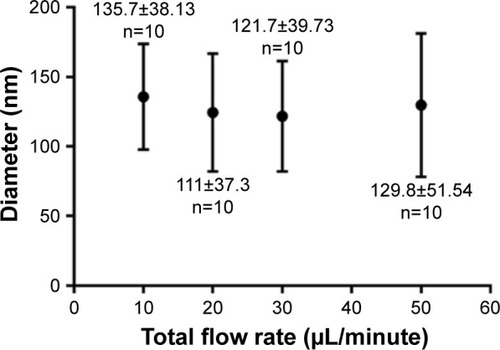
Figure 6 Stability of the budesonide particles.
Note: Particle size distribution 1 hour and 1 day after synthesis.
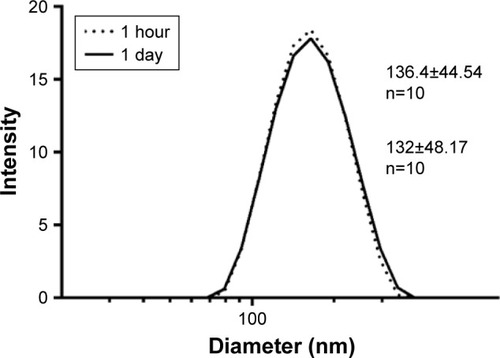
An acoustically enhanced microfluidic method was demonstrated to synthesize highly uniform budesonide nanoparticles with a mean diameter of <150 nm, reducing the size by 40-fold in comparison to earlier works. This was achieved without adding any surfactants into the mixture, hence, significantly simplifying the process and eliminating undesirable complications, which are associated with additives.
Disclosure
The authors report no conflicts of interest in this work.
References
- LiversidgeEMLiversidgeGGDrug nanoparticles: formulating poorly water-soluble compoundsTox Path20083614348
- JunghannsJUMullerRHNanocrystal technology, drug delivery and clinical applicationsInt J Nanomedicine20083329530918990939
- RaoSSongYPeddieFEvansAMParticle size reduction to the nanometer range: a promising approach to improve buccal absorption of poorly water-soluble drugsInt J Nanomedicine201161245125121753876
- SunJWangFSuiYEffect of particle size on solubility, dissolution rate, and oral bioavailability: evaluation using coenzyme Q10 as naked nanocrystalsInt J Nanomedicine201275733574423166438
- HuaMHuaXPolymer nanoparticles prepared by supercritical carbon dioxide for in vivo anti-cancer drug deliveryNano Micro Lett201462023
- ChenXZhangJJXuanJZhuJJMyoglobin/gold nanoparticles/carbon spheres 3-D architecture for the fabrication of a novel biosensorNano Res200923210219
- ZhangLSuTHeBGuZSelf-assembly polyrotaxanes nanoparticles as carriers for anticancer drug methotrexate deliveryNano Micro Lett201462108115
- WuLCaiXNelsonKA green synthesis of carbon nanoparticle from honey for real-time photoacoustic imagingNano Res20136531232523824757
- NanJChenYLiRPolymeric hydrogel nanocapsules: a thermo and pH dual-responsive carrier for sustained drug releaseNano Micro Let201463200208
- De JongWHBormPJDrug delivery and nanoparticles: applications and hazardsInt J Nanomedicine20083213314918686775
- MurthySKNanoparticles in modern medicine: state of the art and future challengesInt J Nanomedicine20072212914117722542
- OnoueSYamadaSChanHKNanodrugs: pharmacokinetics and safetyInt J Nanomedicine201491025103724591825
- PandeyRSharmaSKhullerGKOral solid lipid nanoparticle-based antitubercular chemotherapyTuberculosis (Edinb)2005855–641542016256437
- HeyderJGebhartJRudolfGSchillerCFStahlhofenWDeposition of particles in the human respiratory tract in the size range 0.005–15 μmJ Aerosol Sci1986175811825
- RaufABhatnagarASisodiaSSKharRKAhmadFJLungs deposition and pharmacokinetic study of submicron budesonide particles in Wistar rats intended for immediate effect in asthmaEXCLI J20171623624428507469
- SungJCPulliamBLEdwardsDANanoparticles or drug delivery to the lungsTrends Biotechnol2007251256357017997181
- DuretCWauthozNSebtiTVanderbistFAmighiKNew inhalation-optimized itraconazole nanoparticle-based dry powders for the treatment of invasive pulmonary aspergillosisInt J Nanomedicine201275475548923093903
- MansourHMRheeYSWuXNanomedicine in pulmonary deliveryInt J Nanomedicine2009429931920054434
- ZarogoulidisPChatzakiEPorpodisKInhaled chemotherapy in lung cancer: future concept of nanomedicineInt J Nanomedicine201271551157222619512
- ShaoZShaoJTanBTargeted lung cancer therapy: preparation and optimization of transferrin-decorated nanostructured lipid carriers as novel nanomedicine for co-delivery of anticancer drugs and DNAInt J Nanomedicine2015101223123325709444
- LeeWHLeeCYTrainiDYoungPMInhalation of nanoparticle-based drug for lung cancer treatment: advantages and challengesYoung Asian J Pharm Sci2015106481489
- ManojSManikanandanSKumaraguruAKNanoparticles: a new technology with wide applicationsRes J Nanosci Nanotech201111111
- ThoratAADalviSVLiquid antisolvent precipitation and stabilization of nanoparticles of poorly water soluble drugs in aqueous suspensions: Recent developments and future perspectiveChem Eng J2012181–182134
- ShahPUse of nanotechnologies for drug deliveryMRS Bull20063111894899
- Sierra-PallaresJHuddleTGarcía-SernaJUnderstanding bottom-up continuous hydrothermal synthesis of nanoparticles using empirical measurement and computational simulationNano Res201691133773387
- NerowskiAOpitzJBarabanLCunibertiGBottom-up synthesis of ultrathin straight platinum nanowires: electric field impactNano Res201365303311
- Al-KassasRBansalMShawJNanosizing techniques for improving bioavailability of drugsJ Control Release201726020221228603030
- KalaniMYunusRApplication of supercritical antisolvent method in drug encapsulation: a reviewInt J Nanomedicine201161429144221796245
- MatteucciMEHotzeMAJohnstonKPWilliamsRO3rdDrug nanoparticles by antisolvent precipitation: mixing energy versus surfactant stabilizationLangmuir200622218951895917014140
- HornDRiegerJOrganic nanoparticles in the aqueous phase-theory, experiment, and useAngew Chem Int Ed Engl200140234330436112404417
- GaoLZhangDChenMDrug nanocrystals for the formulation of poorly soluble drugs and its application as a potential drug delivery systemJ Nanopart Res2008105845862
- PhanHVCoşkunMBŞeşenMPandraudGNeildAAlanTVibrating membrane with discontinuities for rapid and efficient microfluidic mixingLab Chip201515214206421626381355
- TattersfieldAEHarrisonTWLow-dose budesonide for asthmaLancet200336193631066106712672304
- GodfreySAvitalARoslerAMandelbergAUwyyedKNebulised budesonide in severe infantile asthmaLancet198728563851852
- de JongsteJCDuivermanEJNebulised budesonide in severe childhood asthmaLancet1989186511388
- TurpeinenMPelkonenASSelroosONikanderKHaahtelaTContinuous versus intermittent inhaled corticosteroid (budesonide) for mild persistent asthma in children – not too much, not too littleThorax201267210010222038795
- JacobsCMüllerRHProduction and characterization of a budesonide nanosuspension for pulmonary administrationPharm Res200219218919411883646
- MüllerRHJacobsCKayserONanosuspensions as particulate drug formulations in therapy. Rationale for development and what we can expect for the futureAdv Drug Deliv Rev200147131911251242
- AliHWeigmannBNeurathMFCollnotEMWindbergsMLehrCMBudesonide loaded nanoparticles with pH-sensitive coating for improved mucosal targeting in mouse models of inflammatory bowel diseasesJ Control Release201418316717724685705
- XuLMHuTTPuYPreparation of high-performance ultra-fine budesonide particles for pulmonary drug deliveryChem Eng J2014252281287
- LindonJCTrenterGEKoppenaalDEncyclopedia of Spectroscopy and Spectrometry2nd edBurlingtonElsevier2010
- HaoJFFangXSZhouYFDevelopment and optimization of solid lipid nanoparticle formulation for ophthalmic delivery of chloramphenicol using a Box-Behnken designInt J Nanomedicine2011668369221556343
- GaltonFMcAlisterBAThe geometric mean, in vital and social statisticsProc R Soc Lond187929365367
- ThøgersenABonsakJFosliCHMuntinghGSize distributions of chemically synthesized Ag nanocrystalsJ App Phys2011110444306
- SabotiDMaverUChanHKPlaninšekONovel budesonide particles for dry powder inhalation prepared using a microfluidic reactor coupled with ultrasonic spray freeze dryingJ Pharm Sci201710671881188828285981
- KaiserALiuTRichteringWSchmidtAMMagnetic capsules and pickering emulsions stabilized by core-shell particlesLangmuir200925137335734119499929
- DalviSVDaveRNControlling particle size of a poorly water-soluble drug using ultrasound and stabilizers in antisolvent precipitationInd Eng Chem Res2009481675817593
- PandeyKChatteADalviSContinuous production of aqueous suspensions of ultra-fine particles of curcumin using ultrasonically driven mixing devicePharm Dev Technol20172211228117622
- JamshidiRRossiDSaffariNInvestigation of the effect of ultrasound parameters on continuous sonocrystallization in a millifluidic deviceCryst Growth Des201616846074619
- LeeJAshokkumarMKentishSEInfluence of mixing and ultrasound frequency on antisolvent crystallisation of sodium chlorideUltrason Sonochem2014211606823948494
- NiiSTakayanagiSGrowth and size control in anti-solvent crystallization of glycine with high frequency ultrasoundUltrason Sonochem20142131182118624373692
- EsmaeiliMAghajaniMAbbasalipourkabirRAmaniABudesonide-loaded solid lipid nanoparticles for pulmonary delivery: preparation, optimization, and aerodynamic behaviourArtif Cells Nanomed Biotechnol20164481964197126758698
